Research Report: TUI Airways, Climate Change Impact & Mitigation
VerifiedAdded on 2023/06/14
|12
|2456
|280
Report
AI Summary
This research report investigates the impact of TUI Airways on climate change and the mitigation approaches adopted by the company. It assesses the environmental impacts of TUI's airline operations, determines the strategies used to mitigate climate change, and recommends further strategies for reducing airline emissions. The study employs both primary data collected through employee surveys and secondary data from journals and online sources. The findings reveal that while TUI has implemented measures to reduce its environmental footprint, further improvements in fuel efficiency, operational efficiencies, and air traffic management are necessary. The report concludes by emphasizing the need for both short-term and long-term strategies to minimize the environmental impact of TUI Airways and other airline companies, explore similar assignments and study tools on Desklib.

Foundation year research project
Paraphrase This Document
Need a fresh take? Get an instant paraphrase of this document with our AI Paraphraser
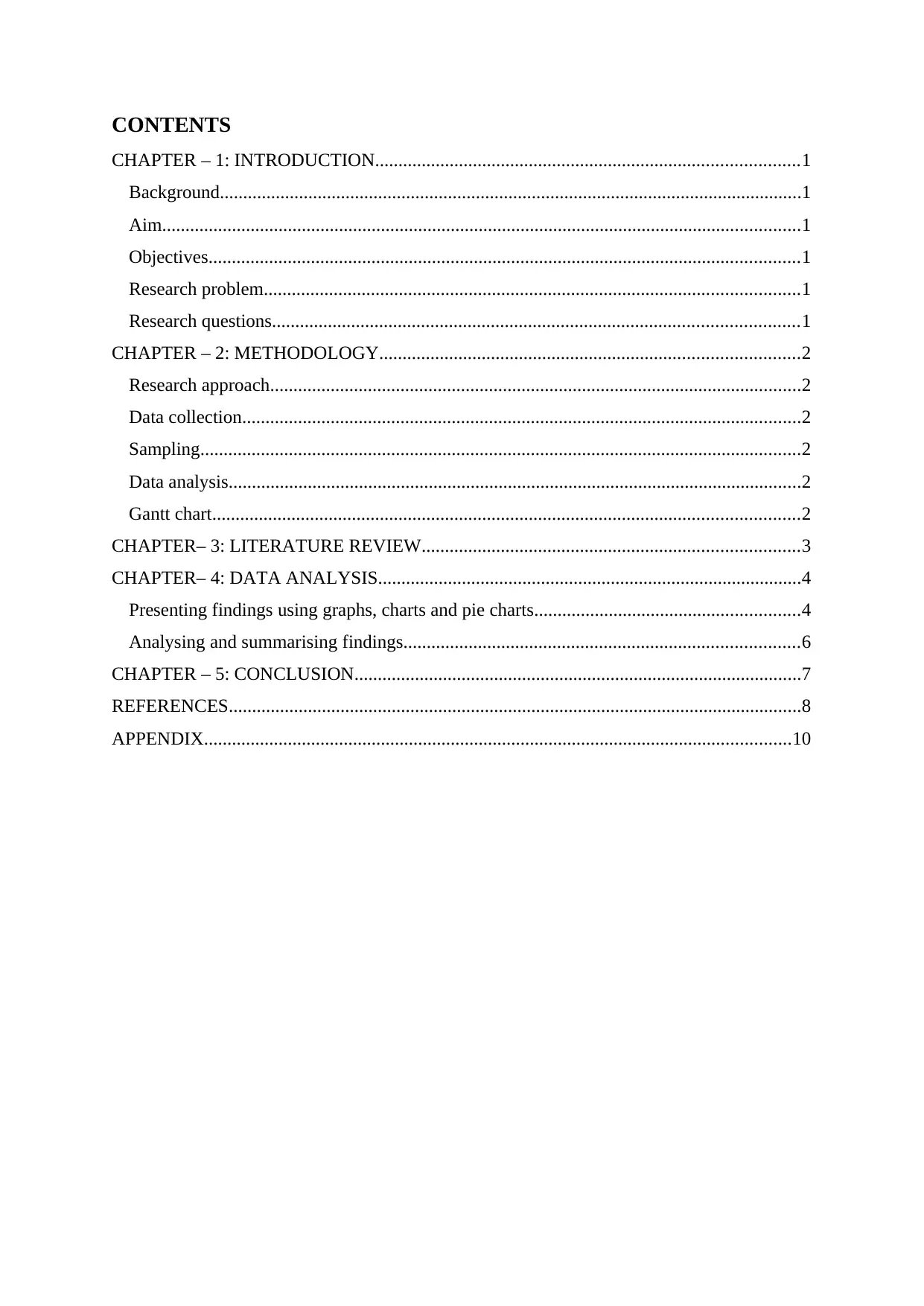
CONTENTS
CHAPTER – 1: INTRODUCTION...........................................................................................1
Background.............................................................................................................................1
Aim.........................................................................................................................................1
Objectives...............................................................................................................................1
Research problem...................................................................................................................1
Research questions.................................................................................................................1
CHAPTER – 2: METHODOLOGY..........................................................................................2
Research approach..................................................................................................................2
Data collection........................................................................................................................2
Sampling.................................................................................................................................2
Data analysis...........................................................................................................................2
Gantt chart..............................................................................................................................2
CHAPTER– 3: LITERATURE REVIEW.................................................................................3
CHAPTER– 4: DATA ANALYSIS...........................................................................................4
Presenting findings using graphs, charts and pie charts.........................................................4
Analysing and summarising findings.....................................................................................6
CHAPTER – 5: CONCLUSION................................................................................................7
REFERENCES...........................................................................................................................8
APPENDIX..............................................................................................................................10
CHAPTER – 1: INTRODUCTION...........................................................................................1
Background.............................................................................................................................1
Aim.........................................................................................................................................1
Objectives...............................................................................................................................1
Research problem...................................................................................................................1
Research questions.................................................................................................................1
CHAPTER – 2: METHODOLOGY..........................................................................................2
Research approach..................................................................................................................2
Data collection........................................................................................................................2
Sampling.................................................................................................................................2
Data analysis...........................................................................................................................2
Gantt chart..............................................................................................................................2
CHAPTER– 3: LITERATURE REVIEW.................................................................................3
CHAPTER– 4: DATA ANALYSIS...........................................................................................4
Presenting findings using graphs, charts and pie charts.........................................................4
Analysing and summarising findings.....................................................................................6
CHAPTER – 5: CONCLUSION................................................................................................7
REFERENCES...........................................................................................................................8
APPENDIX..............................................................................................................................10

CHAPTER – 1: INTRODUCTION
Background
The topic of the current research is analysing the impact of airways on climate change
and approaches adopted to mitigate the same. For the current research purpose TUI airways is
being taken into consideration. TUI was formerly being known as Thomson airways is a
British charter airline. The company is being engaged into the business of offering scheduled
charter flights from United Kingdom and the Republic of Ireland to varied destinations of
Europe, North America, Asia and Africa. Further, the company currently owns around 150
airlines which is contributing more than 5 percent of the greenhouse gas emission towards the
environment (About TUI Group, 2021).
Aim
The main aim of the current research report is to analyse the impact of airways on
climate change and approaches adopted to mitigate the same.
Objectives
To assess the impacts of TUI’s airlines on the environment
To determine the approaches adopted by company to mitigate the impact on climate
change
To recommend other strategies for reducing airline emissions
Research problem
TUI airways is operating around 150 airlines which carries more than 11.8 million
passengers on vacation, business travels and many other purposes. In addition to this, the
company also generates employment opportunities to more than 10000 employees and
contributing nearly € 1.500 billion towards the gross domestic product of European Union.
However, the company is not immune to the influence it has on climate change and
environment (Impact of air travel, 2021). Considering this, the present paper reviews its
impact on environment and the manner it mitigates the same.
Research questions
How growth of TUI’s airlines impact climate change?
What impacts does airlines of TUI have on the environment?
What are some of the approaches adopted by company to mitigate the impact on
climate change?
1
Background
The topic of the current research is analysing the impact of airways on climate change
and approaches adopted to mitigate the same. For the current research purpose TUI airways is
being taken into consideration. TUI was formerly being known as Thomson airways is a
British charter airline. The company is being engaged into the business of offering scheduled
charter flights from United Kingdom and the Republic of Ireland to varied destinations of
Europe, North America, Asia and Africa. Further, the company currently owns around 150
airlines which is contributing more than 5 percent of the greenhouse gas emission towards the
environment (About TUI Group, 2021).
Aim
The main aim of the current research report is to analyse the impact of airways on
climate change and approaches adopted to mitigate the same.
Objectives
To assess the impacts of TUI’s airlines on the environment
To determine the approaches adopted by company to mitigate the impact on climate
change
To recommend other strategies for reducing airline emissions
Research problem
TUI airways is operating around 150 airlines which carries more than 11.8 million
passengers on vacation, business travels and many other purposes. In addition to this, the
company also generates employment opportunities to more than 10000 employees and
contributing nearly € 1.500 billion towards the gross domestic product of European Union.
However, the company is not immune to the influence it has on climate change and
environment (Impact of air travel, 2021). Considering this, the present paper reviews its
impact on environment and the manner it mitigates the same.
Research questions
How growth of TUI’s airlines impact climate change?
What impacts does airlines of TUI have on the environment?
What are some of the approaches adopted by company to mitigate the impact on
climate change?
1
⊘ This is a preview!⊘
Do you want full access?
Subscribe today to unlock all pages.

Trusted by 1+ million students worldwide
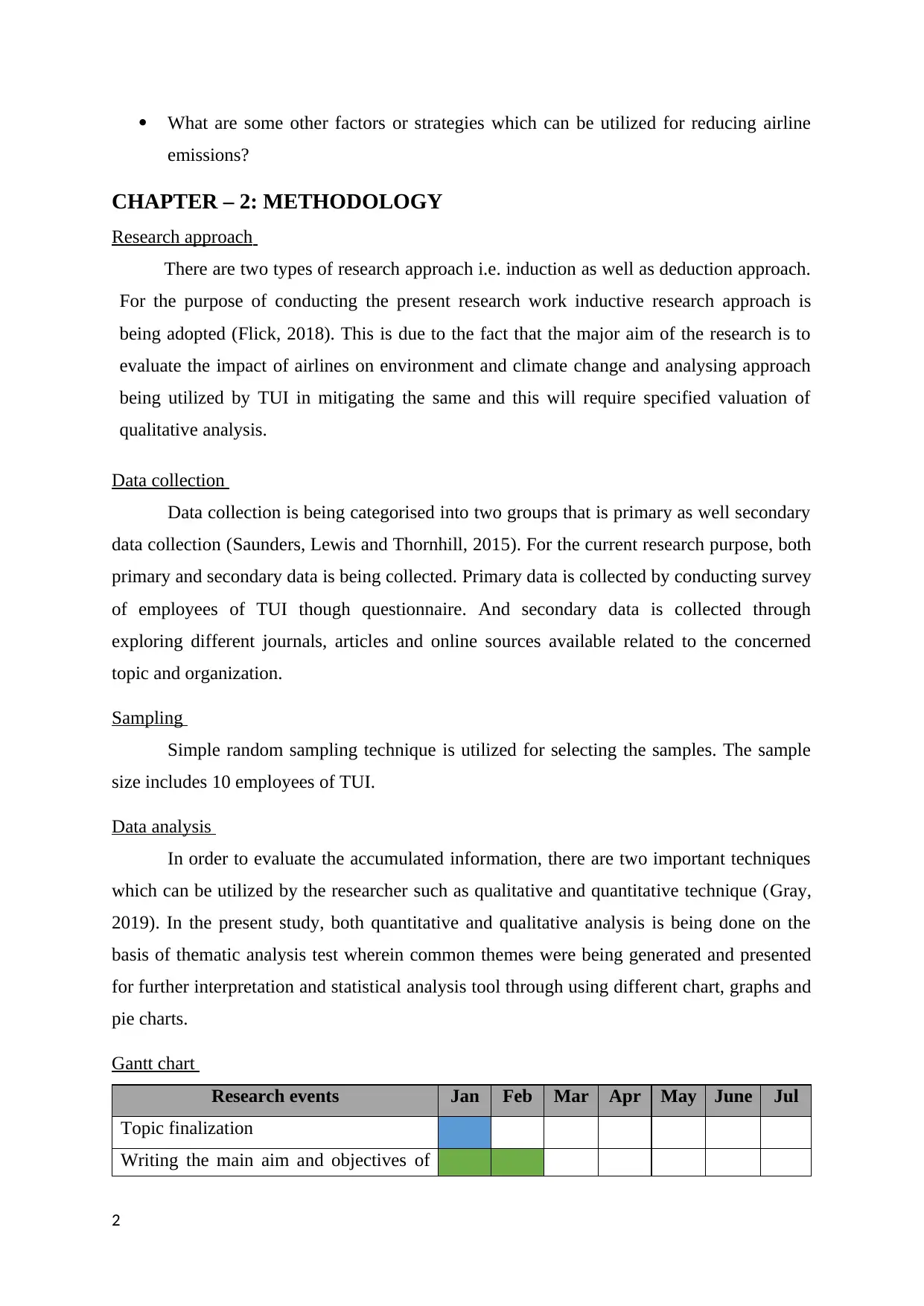
What are some other factors or strategies which can be utilized for reducing airline
emissions?
CHAPTER – 2: METHODOLOGY
Research approach
There are two types of research approach i.e. induction as well as deduction approach.
For the purpose of conducting the present research work inductive research approach is
being adopted (Flick, 2018). This is due to the fact that the major aim of the research is to
evaluate the impact of airlines on environment and climate change and analysing approach
being utilized by TUI in mitigating the same and this will require specified valuation of
qualitative analysis.
Data collection
Data collection is being categorised into two groups that is primary as well secondary
data collection (Saunders, Lewis and Thornhill, 2015). For the current research purpose, both
primary and secondary data is being collected. Primary data is collected by conducting survey
of employees of TUI though questionnaire. And secondary data is collected through
exploring different journals, articles and online sources available related to the concerned
topic and organization.
Sampling
Simple random sampling technique is utilized for selecting the samples. The sample
size includes 10 employees of TUI.
Data analysis
In order to evaluate the accumulated information, there are two important techniques
which can be utilized by the researcher such as qualitative and quantitative technique (Gray,
2019). In the present study, both quantitative and qualitative analysis is being done on the
basis of thematic analysis test wherein common themes were being generated and presented
for further interpretation and statistical analysis tool through using different chart, graphs and
pie charts.
Gantt chart
Research events Jan Feb Mar Apr May June Jul
Topic finalization
Writing the main aim and objectives of
2
emissions?
CHAPTER – 2: METHODOLOGY
Research approach
There are two types of research approach i.e. induction as well as deduction approach.
For the purpose of conducting the present research work inductive research approach is
being adopted (Flick, 2018). This is due to the fact that the major aim of the research is to
evaluate the impact of airlines on environment and climate change and analysing approach
being utilized by TUI in mitigating the same and this will require specified valuation of
qualitative analysis.
Data collection
Data collection is being categorised into two groups that is primary as well secondary
data collection (Saunders, Lewis and Thornhill, 2015). For the current research purpose, both
primary and secondary data is being collected. Primary data is collected by conducting survey
of employees of TUI though questionnaire. And secondary data is collected through
exploring different journals, articles and online sources available related to the concerned
topic and organization.
Sampling
Simple random sampling technique is utilized for selecting the samples. The sample
size includes 10 employees of TUI.
Data analysis
In order to evaluate the accumulated information, there are two important techniques
which can be utilized by the researcher such as qualitative and quantitative technique (Gray,
2019). In the present study, both quantitative and qualitative analysis is being done on the
basis of thematic analysis test wherein common themes were being generated and presented
for further interpretation and statistical analysis tool through using different chart, graphs and
pie charts.
Gantt chart
Research events Jan Feb Mar Apr May June Jul
Topic finalization
Writing the main aim and objectives of
2
Paraphrase This Document
Need a fresh take? Get an instant paraphrase of this document with our AI Paraphraser

the research
Discussion in regards with research
proposal
Writing the proposal
Scripting literatures review
Designing of research methods as well as
approaches
Gathering of secondary information
Inspection of information
Submission of draft work
Writing conclusion
Supplementary draft
Concluding submission
CHAPTER– 3: LITERATURE REVIEW
According to Becken (2015), aviation industry has come a long way and currently
there are uncountable number of commercial flights occupying the skies. Even, TUI airways
is also operating around 150 airlines which carries more than 11.8 million passengers on
vacation, business travels and many other purposes. The company also generates employment
opportunities to more than 10000 employees and contributing nearly € 1.500 billion towards
the gross domestic product of European Union (Luter, 2017). Nevertheless, with this
increasing crowd and growth there has been increase in environmental impacts and climate
change. According to Royal Commission on Environmental Pollution (RCEP) (2018), air
travel has now became one of the fastest mounting foundation for greenhouse gases such as
CO2 which leads to climate change. All this are negatively adding towards increased global
warming, air pollution and noise pollution.
As stated by Lee and Wang (2019), aviation industry has been adopting different
approaches for mitigating the impact on climate change and environment and the time for
zero emission aircraft is still very far away. Different air companies are adopting alternate
fuel or energy solutions to reduce the their impact such as they are making use of solar cells
that converts the solar energy into electricity, fuel cells which converts the hydrogen into heat
etc.(Vespermann and Wald, 2016). TUI is also taking different steps for protecting the
environment like flying more fuel efficient aircrafts, cooperating with different
environmental protection organizations and NGO like MEER, Marine Education Program
3
Discussion in regards with research
proposal
Writing the proposal
Scripting literatures review
Designing of research methods as well as
approaches
Gathering of secondary information
Inspection of information
Submission of draft work
Writing conclusion
Supplementary draft
Concluding submission
CHAPTER– 3: LITERATURE REVIEW
According to Becken (2015), aviation industry has come a long way and currently
there are uncountable number of commercial flights occupying the skies. Even, TUI airways
is also operating around 150 airlines which carries more than 11.8 million passengers on
vacation, business travels and many other purposes. The company also generates employment
opportunities to more than 10000 employees and contributing nearly € 1.500 billion towards
the gross domestic product of European Union (Luter, 2017). Nevertheless, with this
increasing crowd and growth there has been increase in environmental impacts and climate
change. According to Royal Commission on Environmental Pollution (RCEP) (2018), air
travel has now became one of the fastest mounting foundation for greenhouse gases such as
CO2 which leads to climate change. All this are negatively adding towards increased global
warming, air pollution and noise pollution.
As stated by Lee and Wang (2019), aviation industry has been adopting different
approaches for mitigating the impact on climate change and environment and the time for
zero emission aircraft is still very far away. Different air companies are adopting alternate
fuel or energy solutions to reduce the their impact such as they are making use of solar cells
that converts the solar energy into electricity, fuel cells which converts the hydrogen into heat
etc.(Vespermann and Wald, 2016). TUI is also taking different steps for protecting the
environment like flying more fuel efficient aircrafts, cooperating with different
environmental protection organizations and NGO like MEER, Marine Education Program
3
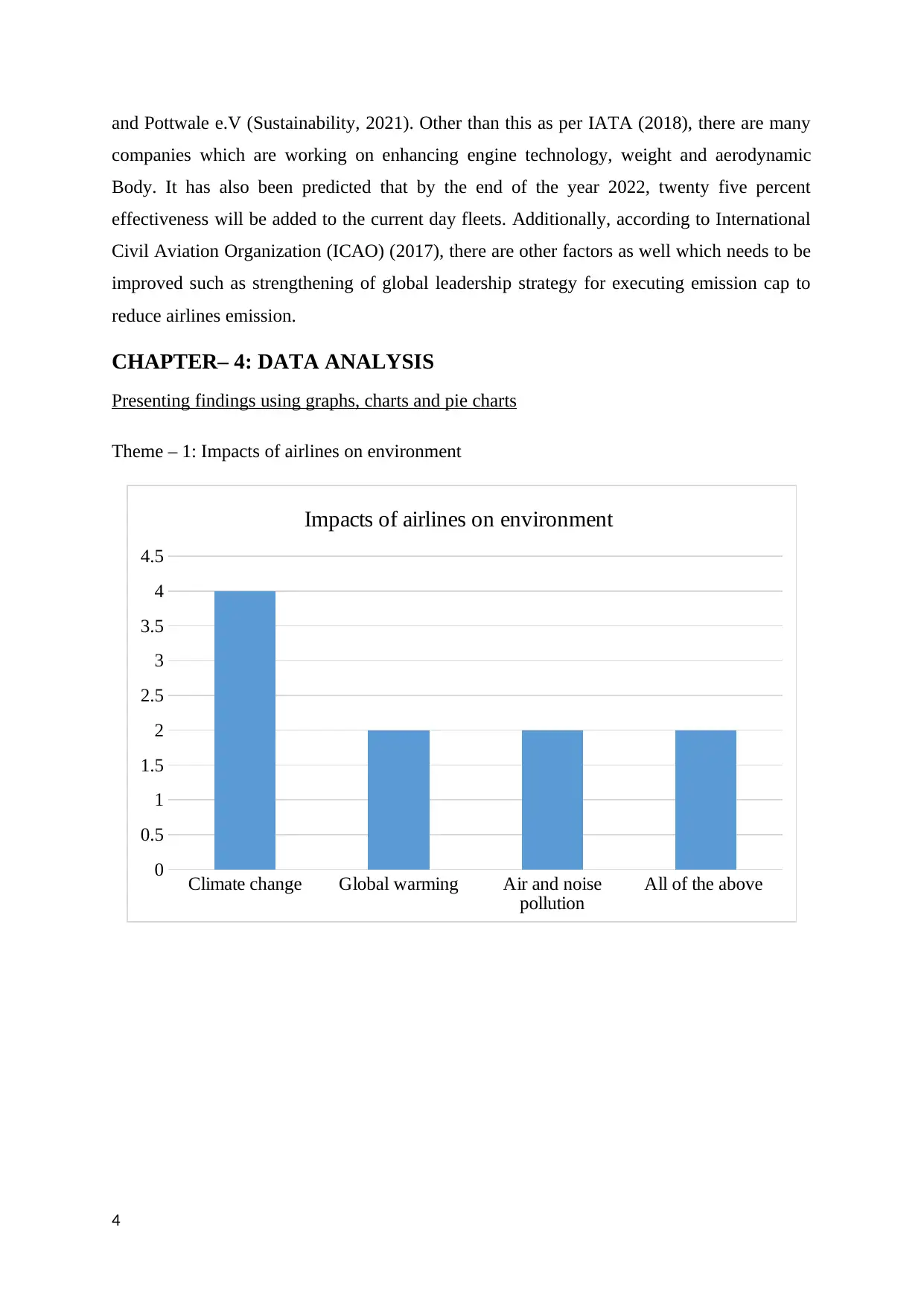
and Pottwale e.V (Sustainability, 2021). Other than this as per IATA (2018), there are many
companies which are working on enhancing engine technology, weight and aerodynamic
Body. It has also been predicted that by the end of the year 2022, twenty five percent
effectiveness will be added to the current day fleets. Additionally, according to International
Civil Aviation Organization (ICAO) (2017), there are other factors as well which needs to be
improved such as strengthening of global leadership strategy for executing emission cap to
reduce airlines emission.
CHAPTER– 4: DATA ANALYSIS
Presenting findings using graphs, charts and pie charts
Theme – 1: Impacts of airlines on environment
Climate change Global warming Air and noise
pollution
All of the above
0
0.5
1
1.5
2
2.5
3
3.5
4
4.5
Impacts of airlines on environment
4
companies which are working on enhancing engine technology, weight and aerodynamic
Body. It has also been predicted that by the end of the year 2022, twenty five percent
effectiveness will be added to the current day fleets. Additionally, according to International
Civil Aviation Organization (ICAO) (2017), there are other factors as well which needs to be
improved such as strengthening of global leadership strategy for executing emission cap to
reduce airlines emission.
CHAPTER– 4: DATA ANALYSIS
Presenting findings using graphs, charts and pie charts
Theme – 1: Impacts of airlines on environment
Climate change Global warming Air and noise
pollution
All of the above
0
0.5
1
1.5
2
2.5
3
3.5
4
4.5
Impacts of airlines on environment
4
⊘ This is a preview!⊘
Do you want full access?
Subscribe today to unlock all pages.

Trusted by 1+ million students worldwide
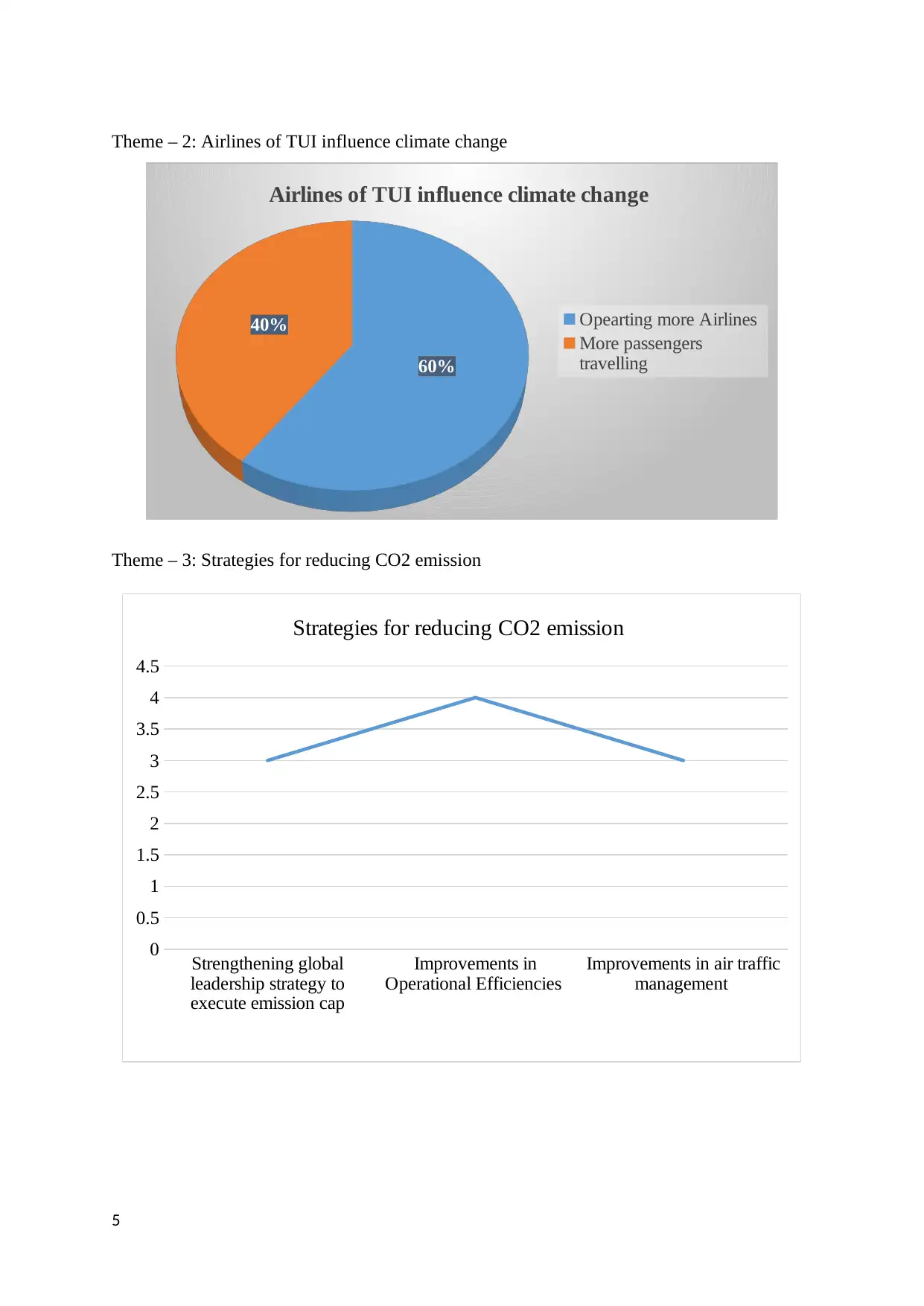
Theme – 2: Airlines of TUI influence climate change
60%
40%
Airlines of TUI influence climate change
Opearting more Airlines
More passengers
travelling
Theme – 3: Strategies for reducing CO2 emission
Strengthening global
leadership strategy to
execute emission cap
Improvements in
Operational Efficiencies
Improvements in air traffic
management
0
0.5
1
1.5
2
2.5
3
3.5
4
4.5
Strategies for reducing CO2 emission
5
60%
40%
Airlines of TUI influence climate change
Opearting more Airlines
More passengers
travelling
Theme – 3: Strategies for reducing CO2 emission
Strengthening global
leadership strategy to
execute emission cap
Improvements in
Operational Efficiencies
Improvements in air traffic
management
0
0.5
1
1.5
2
2.5
3
3.5
4
4.5
Strategies for reducing CO2 emission
5
Paraphrase This Document
Need a fresh take? Get an instant paraphrase of this document with our AI Paraphraser

Theme – 4: TUI’s approaches for mitigating impact on climate change
Alternate fuel or energy sources
Engine technology, aerodynamic body and
weight
Policy mechanism
0 0.5 1 1.5 2 2.5 3 3.5 4 4.5
TUI’s approaches for mitigating impact on climate change
Analysing and summarising findings
From the above presentation of collected information from both primary as well as
secondary sources of data collection, it can be interpreted that both primary and secondary
researches have some common themes and aspects which have been presented in this section.
When the respondents were asked in relation with the impacts of airlines on environment then
around 4 of the participants stated that it leads to change in climate, 2 said that it leads to
global warming, 4 of them said that it results in air and Nosie pollution. It was also originated
from the study that around 60 percent of the participants think that due to operation of more
airlines, the whole environment is impacts. However, there were 40 percent of the
participants who said that it is mainly due to more travelling of the passengers.
The findings also suggests that there are different approaches being adopted by TUI in
order to reduce impact of climate change and environment. It was explored after conducting
the primary research that around 4 of the respondents attributed that their company has been
using alternate fuel and energy sources for reducing emission. They further stated that TUI is
also taking different steps for protecting the environment like flying more fuel efficient
aircrafts, cooperating with different environmental protection organizations and NGO (IPCC,
2017). The other 6 participants were of the view that the company is making use of different
policy mechanism such as imposing requirements on aircraft operations or charging carbon
tax and other charges and engine technology, weight control and aerodynamic body for
6
Alternate fuel or energy sources
Engine technology, aerodynamic body and
weight
Policy mechanism
0 0.5 1 1.5 2 2.5 3 3.5 4 4.5
TUI’s approaches for mitigating impact on climate change
Analysing and summarising findings
From the above presentation of collected information from both primary as well as
secondary sources of data collection, it can be interpreted that both primary and secondary
researches have some common themes and aspects which have been presented in this section.
When the respondents were asked in relation with the impacts of airlines on environment then
around 4 of the participants stated that it leads to change in climate, 2 said that it leads to
global warming, 4 of them said that it results in air and Nosie pollution. It was also originated
from the study that around 60 percent of the participants think that due to operation of more
airlines, the whole environment is impacts. However, there were 40 percent of the
participants who said that it is mainly due to more travelling of the passengers.
The findings also suggests that there are different approaches being adopted by TUI in
order to reduce impact of climate change and environment. It was explored after conducting
the primary research that around 4 of the respondents attributed that their company has been
using alternate fuel and energy sources for reducing emission. They further stated that TUI is
also taking different steps for protecting the environment like flying more fuel efficient
aircrafts, cooperating with different environmental protection organizations and NGO (IPCC,
2017). The other 6 participants were of the view that the company is making use of different
policy mechanism such as imposing requirements on aircraft operations or charging carbon
tax and other charges and engine technology, weight control and aerodynamic body for
6
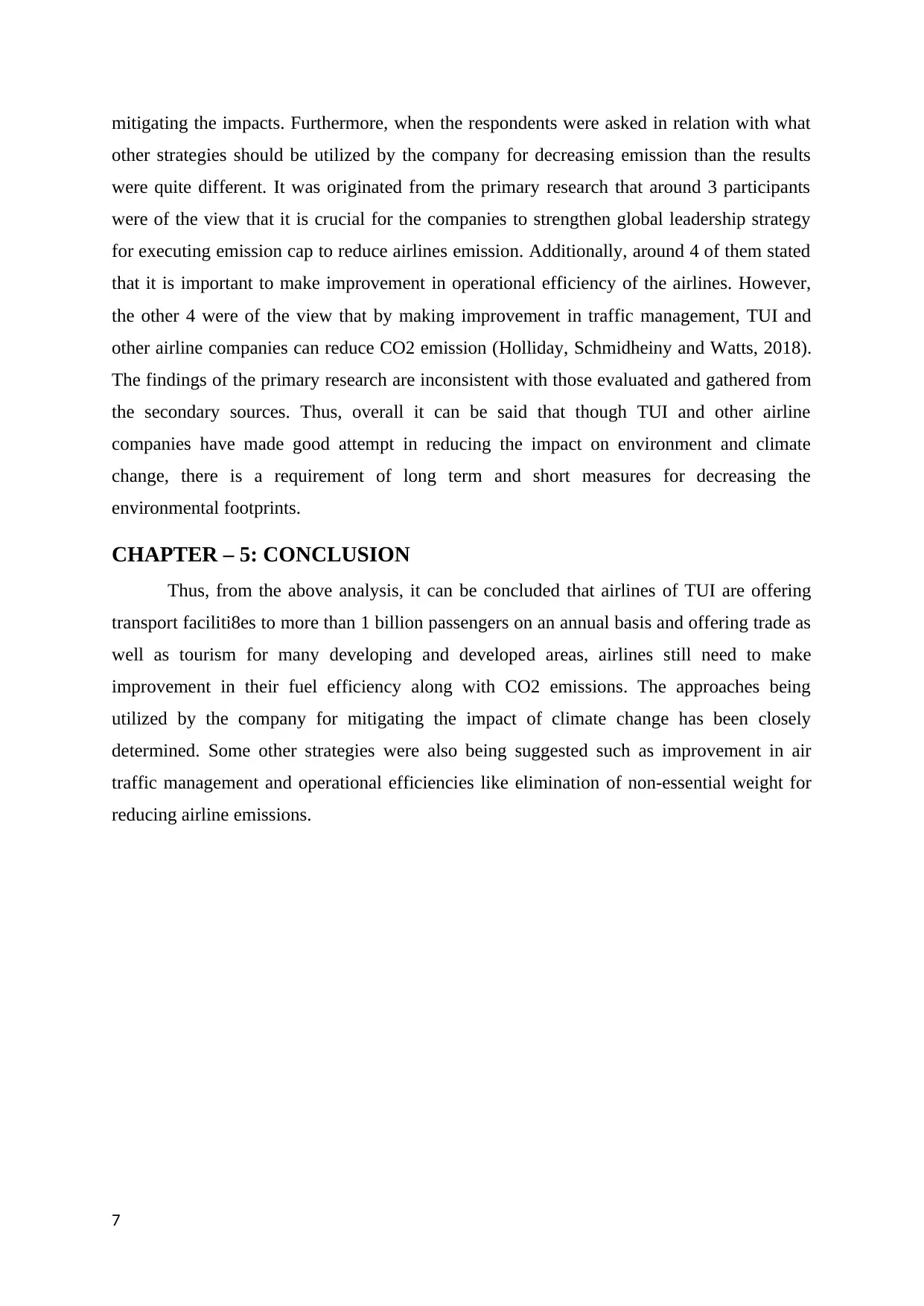
mitigating the impacts. Furthermore, when the respondents were asked in relation with what
other strategies should be utilized by the company for decreasing emission than the results
were quite different. It was originated from the primary research that around 3 participants
were of the view that it is crucial for the companies to strengthen global leadership strategy
for executing emission cap to reduce airlines emission. Additionally, around 4 of them stated
that it is important to make improvement in operational efficiency of the airlines. However,
the other 4 were of the view that by making improvement in traffic management, TUI and
other airline companies can reduce CO2 emission (Holliday, Schmidheiny and Watts, 2018).
The findings of the primary research are inconsistent with those evaluated and gathered from
the secondary sources. Thus, overall it can be said that though TUI and other airline
companies have made good attempt in reducing the impact on environment and climate
change, there is a requirement of long term and short measures for decreasing the
environmental footprints.
CHAPTER – 5: CONCLUSION
Thus, from the above analysis, it can be concluded that airlines of TUI are offering
transport faciliti8es to more than 1 billion passengers on an annual basis and offering trade as
well as tourism for many developing and developed areas, airlines still need to make
improvement in their fuel efficiency along with CO2 emissions. The approaches being
utilized by the company for mitigating the impact of climate change has been closely
determined. Some other strategies were also being suggested such as improvement in air
traffic management and operational efficiencies like elimination of non-essential weight for
reducing airline emissions.
7
other strategies should be utilized by the company for decreasing emission than the results
were quite different. It was originated from the primary research that around 3 participants
were of the view that it is crucial for the companies to strengthen global leadership strategy
for executing emission cap to reduce airlines emission. Additionally, around 4 of them stated
that it is important to make improvement in operational efficiency of the airlines. However,
the other 4 were of the view that by making improvement in traffic management, TUI and
other airline companies can reduce CO2 emission (Holliday, Schmidheiny and Watts, 2018).
The findings of the primary research are inconsistent with those evaluated and gathered from
the secondary sources. Thus, overall it can be said that though TUI and other airline
companies have made good attempt in reducing the impact on environment and climate
change, there is a requirement of long term and short measures for decreasing the
environmental footprints.
CHAPTER – 5: CONCLUSION
Thus, from the above analysis, it can be concluded that airlines of TUI are offering
transport faciliti8es to more than 1 billion passengers on an annual basis and offering trade as
well as tourism for many developing and developed areas, airlines still need to make
improvement in their fuel efficiency along with CO2 emissions. The approaches being
utilized by the company for mitigating the impact of climate change has been closely
determined. Some other strategies were also being suggested such as improvement in air
traffic management and operational efficiencies like elimination of non-essential weight for
reducing airline emissions.
7
⊘ This is a preview!⊘
Do you want full access?
Subscribe today to unlock all pages.

Trusted by 1+ million students worldwide

REFERENCES
Books and journals
Becken, S., 2015. How Tourist and Tourism experts perceive climate change and carbon
offsetting schemes. Journal of Sustainable Tourism, 12 (4), pp.332-345.
Flick, U., 2018. Introducing Research Methodology: A Beginner’s Guide to Doing a
Research Project. London: SAGE.
Gray, D., 2019. Doing Research in the Real World. 2nded. London: SAGE.
Holliday, J.C., Schmidheiny, S. and Watts, P., 2018. Walking the Talk - The Business Case
or Sustainable Development. Sheffield, UK: Greenleaf Publishing Ltd.
IATA. 2018. Building a Greener Future. 3rded. International Air Transport Association.
ICAO. 2017. Working Paper. Assembly — 36th Session. Agenda Item 40: Regulation of
international air transport services. Taxation of Aircraft Fuel. ICAO guidelines and
toolkit.
IPCC. 2017. Climate Change 2007: AR4 Synthesis Report. Cambridge University Press.
Lee, H. and Wang, W., 2019. Environmental Impacts and Policy Options for Aviation:
Taiwan’s Responses within the Global Framework, Terrestrial, Atmospheric and
Oceanic Sciences. TAO, 12(1), pp.195-208.
Luter, L., 2017. Environmental impacts of airport operations, maintenance, and expansion.
Washington: CRS Report for Congress.
ROYAL COMMISSION ON ENVIRONMENTAL POLLUTION (RCEP), 2017. The
Environmental Effects of Civil Aircraft in Flight (November 29). Short Reports -
Aviation.
Saunders, M., Lewis, P. and Thornhill, A., 2015. Research methods for Business Students.
6thed. Harlow: Pearson.
Vespermann, J. and Wald, A., 2016. Much ado about Nothing? – An analysis of economic
impacts and ecologic effects of the EU-emission trading scheme in the aviation
industry. Transportation Research Part A: Policy and Practice, 45(10), pp.1066–1076.
Online references
About TUI Group. 2021. [Online]. Available through:
https://www.tuigroup.com/en-en/about-us/about-tui-group>. [Accessed on 22thJanuary
2022].
Impact of air travel. 2021. [Online]. Available through: <https://www.greenchoices.org/eco-
holidays/environmental-impacts>. [Accessed on 22thJanuary 2022].
8
Books and journals
Becken, S., 2015. How Tourist and Tourism experts perceive climate change and carbon
offsetting schemes. Journal of Sustainable Tourism, 12 (4), pp.332-345.
Flick, U., 2018. Introducing Research Methodology: A Beginner’s Guide to Doing a
Research Project. London: SAGE.
Gray, D., 2019. Doing Research in the Real World. 2nded. London: SAGE.
Holliday, J.C., Schmidheiny, S. and Watts, P., 2018. Walking the Talk - The Business Case
or Sustainable Development. Sheffield, UK: Greenleaf Publishing Ltd.
IATA. 2018. Building a Greener Future. 3rded. International Air Transport Association.
ICAO. 2017. Working Paper. Assembly — 36th Session. Agenda Item 40: Regulation of
international air transport services. Taxation of Aircraft Fuel. ICAO guidelines and
toolkit.
IPCC. 2017. Climate Change 2007: AR4 Synthesis Report. Cambridge University Press.
Lee, H. and Wang, W., 2019. Environmental Impacts and Policy Options for Aviation:
Taiwan’s Responses within the Global Framework, Terrestrial, Atmospheric and
Oceanic Sciences. TAO, 12(1), pp.195-208.
Luter, L., 2017. Environmental impacts of airport operations, maintenance, and expansion.
Washington: CRS Report for Congress.
ROYAL COMMISSION ON ENVIRONMENTAL POLLUTION (RCEP), 2017. The
Environmental Effects of Civil Aircraft in Flight (November 29). Short Reports -
Aviation.
Saunders, M., Lewis, P. and Thornhill, A., 2015. Research methods for Business Students.
6thed. Harlow: Pearson.
Vespermann, J. and Wald, A., 2016. Much ado about Nothing? – An analysis of economic
impacts and ecologic effects of the EU-emission trading scheme in the aviation
industry. Transportation Research Part A: Policy and Practice, 45(10), pp.1066–1076.
Online references
About TUI Group. 2021. [Online]. Available through:
https://www.tuigroup.com/en-en/about-us/about-tui-group>. [Accessed on 22thJanuary
2022].
Impact of air travel. 2021. [Online]. Available through: <https://www.greenchoices.org/eco-
holidays/environmental-impacts>. [Accessed on 22thJanuary 2022].
8
Paraphrase This Document
Need a fresh take? Get an instant paraphrase of this document with our AI Paraphraser
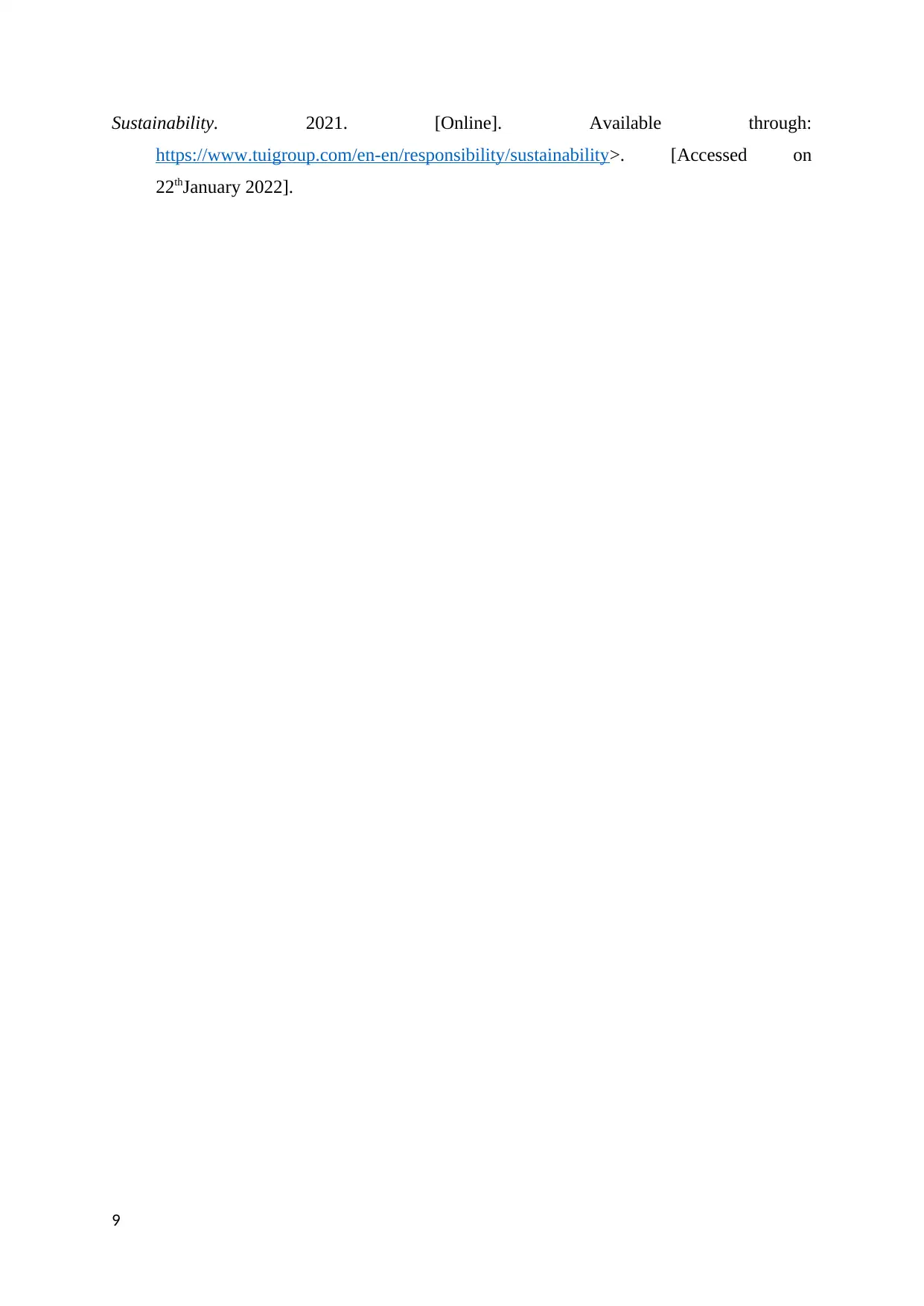
Sustainability. 2021. [Online]. Available through:
https://www.tuigroup.com/en-en/responsibility/sustainability>. [Accessed on
22thJanuary 2022].
9
https://www.tuigroup.com/en-en/responsibility/sustainability>. [Accessed on
22thJanuary 2022].
9
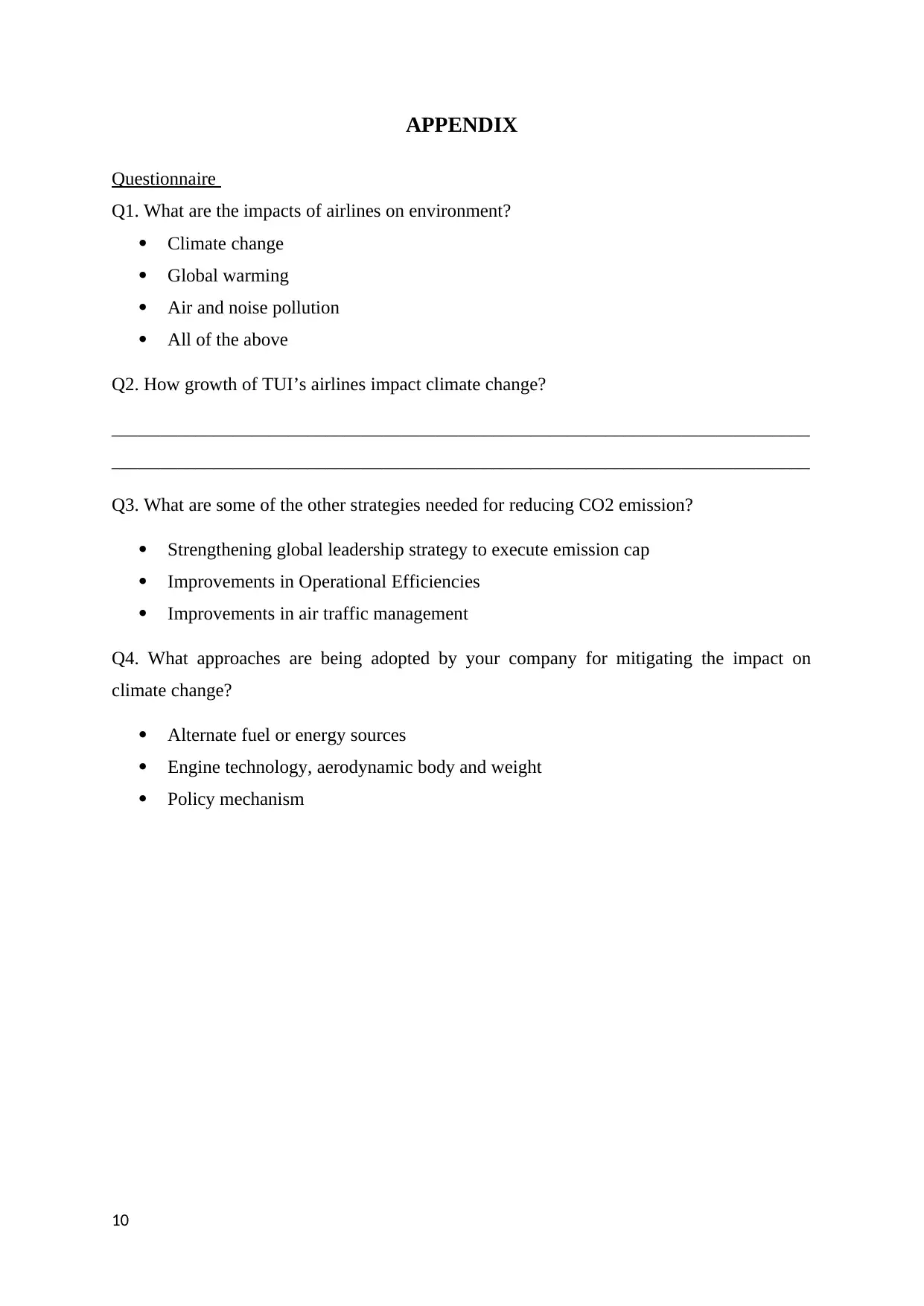
APPENDIX
Questionnaire
Q1. What are the impacts of airlines on environment?
Climate change
Global warming
Air and noise pollution
All of the above
Q2. How growth of TUI’s airlines impact climate change?
___________________________________________________________________________
___________________________________________________________________________
Q3. What are some of the other strategies needed for reducing CO2 emission?
Strengthening global leadership strategy to execute emission cap
Improvements in Operational Efficiencies
Improvements in air traffic management
Q4. What approaches are being adopted by your company for mitigating the impact on
climate change?
Alternate fuel or energy sources
Engine technology, aerodynamic body and weight
Policy mechanism
10
Questionnaire
Q1. What are the impacts of airlines on environment?
Climate change
Global warming
Air and noise pollution
All of the above
Q2. How growth of TUI’s airlines impact climate change?
___________________________________________________________________________
___________________________________________________________________________
Q3. What are some of the other strategies needed for reducing CO2 emission?
Strengthening global leadership strategy to execute emission cap
Improvements in Operational Efficiencies
Improvements in air traffic management
Q4. What approaches are being adopted by your company for mitigating the impact on
climate change?
Alternate fuel or energy sources
Engine technology, aerodynamic body and weight
Policy mechanism
10
⊘ This is a preview!⊘
Do you want full access?
Subscribe today to unlock all pages.

Trusted by 1+ million students worldwide
1 out of 12
Related Documents
Your All-in-One AI-Powered Toolkit for Academic Success.
+13062052269
info@desklib.com
Available 24*7 on WhatsApp / Email
![[object Object]](/_next/static/media/star-bottom.7253800d.svg)
Unlock your academic potential
Copyright © 2020–2025 A2Z Services. All Rights Reserved. Developed and managed by ZUCOL.





